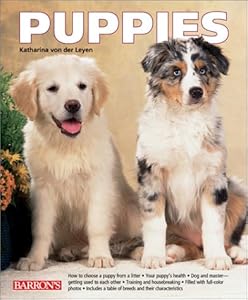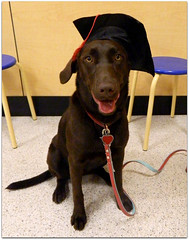 |
| English: Picture of Rufus as a puppy (Photo credit: Wikipedia) |
There are many reasons to have a pet puppy. Perhaps it was
that irresistible puppy or the puppy with lovable eyes! An obedient puppy is
certainly an ideal puppy. Training is what accomplishes this. In this article,
you will find useful tips for your puppy training.
You can use a can that you shake at your puppy to train
them. Seal up a can with some coins inside. Shake the can whenever your puppy
does something wrong. This will get the puppy's attention and take his mind off
of what he was doing. After a few times of this, your puppy will get that this
is not the behavior you want. Shake the can only once to avoid desensitizing
your puppy.
Understand limitations of older puppies. You will be unable
to train an older puppy perfectly; embrace their personality and quirks! If you
decide to adopt an older pooch, you may end up with a puppy that is pretty set
in his ways. While teaching new habits to him may not be impossible, it is
sometimes better to focus on negative things you can change and get used to
living with the other habits.
A good way to learn when your dog needs to go outside is by using a technique called bell ringing. Begin by ringing a bell to let your puppy know it's time to go outside. Leave the bell positioned so the dog can ring it, and soon he will ring it to inform you that it's time to go outside. As long as you do this every time you take them out, soon the dog will use the bell to let you know he has to go.
Do not expect miracles if poor behavior is ingrained. Puppy's who have slept on furniture for years will need patience in order to change.
With some time, your puppy will be able to tell you when he needs to go outside. When your puppy jumps on you, take its paws in your hands and lightly squeeze them to let it know that jumping on people is not an acceptable behavior. It is uncomfortable to them when you squeeze gently, and they learn not to repeat the behavior. After some time, they won't jump on anyone because they'll associate it with being made to feel uncomfortable. When you are trying to house train your puppy, keep in mind that everything that you put in, will come out. Feed your puppy three times regularly each day.
Doing so allows you to gain a clearer picture of when your puppy might need to relieve himself outdoors. When teaching a puppy to sit, start by holding a treat above him while he stands. Move the treat just above the puppy's head, moving a hand behind the dog. He'll look up at where your hand is. When a puppy makes this motion, their instinct is to sit down.
Though you actually can teach older puppys some new things, it is important to take note of medical problems or other conditions that could reduce an older puppy's readiness to perform certain tasks. Dogs with arthritis, for example, shouldn't be asked to crawl all over.
Even when it is amusing, you have to correct your puppy, not reward him with laughter. It is important to have flexible methods of training when teaching your puppy. When you are flexible, you will be better able to teach. Tweak the technique until you find a plan that works for you and your puppy. During the earliest days of training your pet, stick with simple directives. Aside from being rewarded instantly for your success, this will also give your puppy the important basis of what is an acceptable behavior or trick. This will give you positive results from the onset. In order to train your dog well, you must maintain an open mind in your methods. Being flexible with your training will help you when your puppy is struggling to learn. You'll then be able to tweak your techniques to fit your puppy and situation, so you'll have a better chance of success.
As your puppy progresses, you won't need to exert so much control. The balance between freedom and obedience will give your puppy a satisfying life.
It is vital to keep some slack in the leash when you are trying to train a dog. When dogs are going for a walk, they will often want to check out new territory.
These puppies just need a bit more time. Sometimes, more patience is required than others for certain breeds, such as a basset hound or beagle. Do you know what you need to get started? Hopefully, you've gotten enough ideas here to get started. Nothing is better than a well-trained puppy. Proper training takes time. Years into your relationship, you will be glad you made the effort.
Always be on the lookout for opportunities to put these great tips into action. Your puppy must learn the "down" command. This command is a basic one that can be built upon. A dog who is well trained to drop on command is a much safer pooch.


